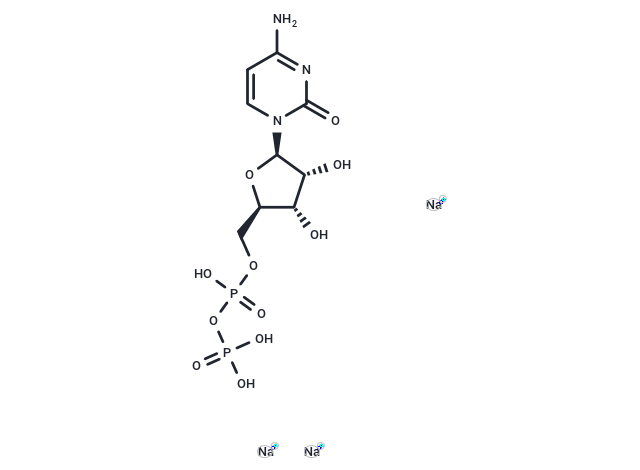Shopping Cart
Remove All Your shopping cart is currently empty
Your shopping cart is currently empty
Cytidine 5'-diphosphate trisodium salt (CDP) catalyzes the production of Cytidine triphosphate (CTP) for DNA and RNA synthesis by transferring a phosphoryl group from ATP to cytidine monophosphate (CMP) through the action of uridine monophosphate kinase (UMPK).

| Pack Size | Price | USA Warehouse | Global Warehouse | Quantity |
|---|---|---|---|---|
| 5 mg | $29 | In Stock | In Stock | |
| 10 mg | $43 | In Stock | In Stock | |
| 25 mg | $68 | In Stock | In Stock | |
| 50 mg | $94 | In Stock | In Stock | |
| 100 mg | $125 | In Stock | In Stock | |
| 200 mg | $178 | In Stock | In Stock |
| Description | Cytidine 5'-diphosphate trisodium salt (CDP) catalyzes the production of Cytidine triphosphate (CTP) for DNA and RNA synthesis by transferring a phosphoryl group from ATP to cytidine monophosphate (CMP) through the action of uridine monophosphate kinase (UMPK). |
| In vivo | Cytidine 5'-diphosphate trisodium salt-ribitol can be used for the Diagnostics and research of Cytidine 5'-diphosphate trisodium salt-l-ribitol pyrophosphorylase A (CRPPA) muscular dystrophy [2] . |
| Synonyms | CDP |
| Molecular Weight | 472.15 |
| Formula | C9H15N3Na3O11P2 |
| Cas No. | 34393-59-4 |
| Smiles | O=C1N([C@H]2[C@H](O)[C@H](O)[C@@H](COP(O)(OP(O)(O)=O)=O)O2)C=CC(N)=N1.[Na+].[Na+].[Na+] |
| Relative Density. | no data available |
| Color | White |
| Appearance | Solid |
| Storage | Powder: -20°C for 3 years | In solvent: -80°C for 1 year | Shipping with blue ice/Shipping at ambient temperature. | |||||||||||||||||||||||||||||||||||
| Solubility Information | H2O: 245 mg/mL (518.9 mM), Sonication is recommended. | |||||||||||||||||||||||||||||||||||
Solution Preparation Table | ||||||||||||||||||||||||||||||||||||
H2O
| ||||||||||||||||||||||||||||||||||||
| Size | Quantity | Unit Price | Amount | Operation |
|---|

Copyright © 2015-2026 TargetMol Chemicals Inc. All Rights Reserved.